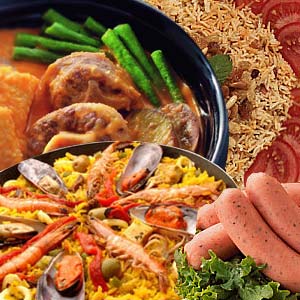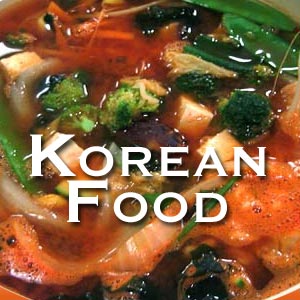Filipino Cuisine

Filipino cuisine or Philippines cuisine has the tang of the Chinese, Spanish, Mexican, American, Malay and Indian flavors. The food consumed and prepared by the people of Philippines is as varied as the diverse traditional factions that constitute the Filipino people. Filipinos consume three major meals a day - 'almusal'- breakfast, 'tanghalian' - lunch, and 'hapunan'- dinner and a light snack 'merienda' in the afternoon.
Freshly cultivated fruits and vegetables form the main ingredients of any meal along with meat, fish and poultry, rice (kanin). The food is seasoned by the rich selection of special herbs and spices that are collected from all over the island. Filipinos eat their food using fork, spoon and knife, food is eaten using the hands when dry dishes are served.
Filipino food
Filipino cuisine includes a large variety of food ranging from simple meals to wholesome rich cuisines. The simple meals include a dish of rice and fish and the rich ones include paellas and cocidos. Well-liked and well-known dishes include whole roasted pig (lechon), omelet (torta), native sausage (longanisa), bread rolls (pan de sal), oxtail or pieces of beef and tripe cooked in peanut sauce (kare-kare), mixed cold fruit desert (halo-halo) etc.
Breakfast or almusal: Filipinos have a customary method of serving and preparing dishes for breakfast. The dishes are served in various ways that typically include:
- Longsilog: Sweet and spicy sausages from the province of Pampanga, Vigan or Lucban, along with sinangag and itlog served with tomato slices and vinegar or pickles (achara)
- Tosilog: Sweetened cured pork or chicken breast served with sinangag and itlog, and slices of tomato, vinegar and achara
- Tapsilog: Filipino garlic fried rice with thinly sliced cured meat with egg and thinly sliced tomato or vinegar
- Pan de sal: A Spanish name for bread with salt filled or spread with jam, marmalade etc.
- Champorado: A type of rice porridge flavored with chocolate.
- Daing na Bangus: Dried and salted milkfish served with sinangag and fried eggs and with tomato slices and vinegar or pickles (achara)
Merienda or snack: Along with tea (chaa), coffee (kape) or hot chocolate bread, spicy dishes are also served.
Lunch or tanghalian: Sweet, sour, spicy and salty combinations of food constitute any major meal of the Filipinos. Main dishes in the Filipino meal are Sinigang - pork, fish, shrimp in tamarind stew and vegetables, kare-kare - oxtail and vegetables cooked in peanut sauce, mechado - pork cooked in tomato sauce, etc.
Dinner or hapunan Stir-fried vegetables along with dishes that are served for lunch along with achara or pickles and desert constitute dinner.
Filipino cooking style
Early settlers or civilization of the Philippines cooked their food by either roasting, steaming or boiling. Later food preparation methods of the Filipinos were influenced by the Malay style of cooking in the Pre-Hispanic era and thus food was cooked by boiling, roasting or steaming. Meat included pork, fowl, dog, fish etc. Business with China and other parts of Asia brought in food influenced from these parts of the world too, famous among them being fish sauce (patis) and soy sauce (toyo), aromatic soups and stir frying methods. Few of the popular methods of cooking include:
- Kinilaw or Kilawin - Raw fish marinated in vinegar until the fish cooks as expected
- Prito - Fried or deep fried
- Ginataan - Cooked with coconut milk
- Inadobo - Cooked in soy sauce, vinegar and garlic
- Nilaga - boiled with black pepper and onions
- Guisado - sautéed with garlic, tomatoes and onions
- Inihaw - grilled over coal
- Sinigang - Boiled with a tamarind base
- Pinaksiw - Cooked in vinegar and ginger
Of the cooking methods listed above nilaga, inihaw, roasting and guisado, are very famous. Current healthy cooking methods have been an integral part of the Filipinos cooking.
Philippines food
Sour and salty flavors dominate Filipino cooking. Filipino food is characterized by a dish called sinigang - fish slightly boiled in sour stock of vegetables and fish sauce. Fish is the favorite seafood when compared to shrimp etc. Fish is best liked by Filipinos when it is raw and enjoyed most when it is in the form of kilawin (vinaigrette), inihaw (grilled) or just stuffed with onions and enclosed in a banana leaf.
Food in Philippines is not very spicy and is usually bland and mild, chilies are kept at bay. Thus for people with sensitive taste buds Filipino cuisine is the best. Sour flavor is derived from cooking in vinegar, tamarind, mango, guava and kalamansi (cross between lime and orange).
Salt flavor is derived from shrimp paste, fish sauce, patis sauce, bagoong paste and soy sauce (borrowed from the Chinese). Chinese traders introduced concepts of stir fried cooking; noodles, soy based cooking etc and the early Spaniards introduced stews, sausages, dairy, and meat products.
Coconut and coconut milk is used copiously in most Filipino dishes thus adding to the taste and flavor. Meat and vegetables cooked in coconut milk bring out a unique flavor in them and coconut milk is used to prepare some mouthwatering deserts too.
Some of the popular ingredients that can be found in the Filipino cuisine are coconut, chilies, Chinese sausages, garlic, corn flour, mushrooms, ginger, tomatoes, pandan leaf (screw pine), tanglad (lemon grass).
Popular Filipino recipes
Stuffed milk fish
big bangus (milkfish)
ham, finely chopped
1 egg
1 onion chopped
1 small carrot, finely chopped
cooked peas
2 tomatoes, diced
raisins
3 cloves of garlic, minced
1/4 cup lemon juice
1/4 cup soy sauce
4 tablespoons of cooking oil
salt and pepper to taste
Scale the fish and remove the intestines. Using a sharp knife make an open cavity below the head and remove the meat of the fish through this. Remove the spine of the fish by cracking off the bones at the head and the tail base. Remove all the meat from the skin. Marinate the skin and the head in lemon juice, soy sauce and pepper. Boil the fish meat in water added with salt for 5 minutes.
Sauté onions and garlic till brown and add carrot and tomatoes and cook till they are tender. Add cooked peas, chopped ham, raisins, and the milk fish meat to the mixture and cook for another 5 minutes and add salt and pepper as per requirement. Add a beaten egg along with the rest of the mixture. Stuff this mixture in the head and the skin of the milk fish and sew ends if required. Deep fry in oil till it becomes brown in color. Slice and serve hot.
Kare-Kare
Oxtail or beef 1 kilo
Chinese spinach 2 stems (cut)
String beans 10 pieces (cut length wise)
Aubergine 3 no (cut)
Onion 1 (chopped)
Garlic 3 cloves (finely minced)
Achiote seeds soaked and squeezed in water
Peanut butter 1 cup
Rice 1 cup
Banana blossom cut in big pieces
Salt and pepper
Boil oxtail in water for 11/2 and 2 hours. Roast rice until golden brown and process in food processor. Heat oil in a wok or large and sauté garlic and onion. Add banana blossom and 1 cup of achiote seed water. Later add aubergine, string beans and Chinese spinach. Blend in peanut butter and rice and add the tenderized oxtail. Add some more water and boil till it simmers. Season with shrimp paste and bagoong and serve
Top of the Page: Filipino Cuisine
Tags:#Filipino cuisine #filipino dishes for lunch #filipino food recipes
 Foodie in You
Foodie in You Chicken Breast Recipes
Easy Salad recipes
Chicken Salad Recipe
Asian Food Recipes
 Filipino Cuisine
Filipino Cuisine Japanese Food Recipe
Chinese Food Recipe
Chinese Sauce
Beijing Duck
Dim Sum
Malaysian Food
Thai Food Recipe
Teriyaki Sauce
American Food Recipes
Cajun Food Recipe
Mexican Food Recipe
European Food Recipes
 Tiramisu Cake
Tiramisu Cake German Food
French Cuisine
Quiche Recipe
Mediterranean Recipe
Frittata Recipe
Greek Food
Type of Pasta
Pasta Salad Recipe
Tartar Sauce
Marinara Sauce
Jamaican Food
Moroccan Food
Top of the Page: Filipino Cuisine
Popularity Index: 101,595

